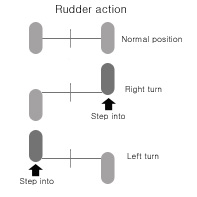Beginner's Introduction to Flight Simulator School
|
COMPUTER PILOT ACADEMIY
|
|
3.Flight training

The actual start of training finally.Now, please got in the cockpit.
At least in the cockpit before the flight, please check the following.
Did you choose your favorite airplane?
Can I see around the cockpit?
Ailerons, elevators, flaps, slots, does it work properly?

Taxiing to the
Taxing and can not be satisfactorily takeoff.
Please practice good but unspectacular.

The pilot taxiing the plane in the direction of rudder use.
If you have rudder pedals, do the footwork like a real airplane.
If you are using an integrated joystick operates by twisting the rudder stick.
Description has assumed that rudder pedals.
Fig-3.1.1 changes the direction of the rudder pedal and so on.


t

The actual start of training finally.Now, please got in the cockpit.
At least in the cockpit before the flight, please check the following.
Did you choose your favorite airplane?
Can I see around the cockpit?
Ailerons, elevators, flaps, slots, does it work properly?

3.1.Taxiing
[Taxiing training is important!]Taxiing to the
- in the airport hangar (airport gate) is going to take off from the point.
- After landing, hangar (airport gate) is going to.
- If the straightness of the takeoff run.
Taxing and can not be satisfactorily takeoff.
Please practice good but unspectacular.
The pilot taxiing the plane in the direction of rudder use.
If you have rudder pedals, do the footwork like a real airplane.
If you are using an integrated joystick operates by twisting the rudder stick.
Description has assumed that rudder pedals.
Fig-3.1.1 changes the direction of the rudder pedal and so on.
 |
Basic operation If the nose of the plane would turn right into the depression to the right pedal, turn them to the left when the left pedal depression. Operation amount (depression amount) is slowly (conservative), the trick is to ensure that the depression. The first would tread too slow to respond because of the rudder. Please note that because I will put a serpentine counter. Also differ by an airplane rudder feel you have selected. If it is absolutely unsuitable for adjusting the sensitivity of the rudder. Most software can be adjusted. |
| Fig-3.1.1 |
| Training Items: | Turn stationary |
| Objectives / Training procedures | Knack of technical improvement | Required credits |
||
| Objectives |
|
90〜180° Left&Right 50times Practice Time 2 hours |
||
| When do you want to rotate and change direction at the minimum radius of the runway after landing. | ||||
| Training procedures | ||||
|
||||
| fig-3.1.2 |
| Training Items: | Dead slow turnaround |
| Objectives / Training procedures | Knack of technical improvement | Required credits |
||
| Objectives |
|
90〜180" Left&right 50times Practice Time 4 hours |
||
| Practice running through the runway during takeoff from the tarmac. Driving practice before tarmac of the runway after landing. |
||||
| Training procedures | ||||
|
||||
| fig-3.1.3 |
| Training Items: | Takeoff run training |
| Objectives / Training procedures | Knack of technical improvement | Required credits |
||
| Objectives |
|
100 round trip Practice Time 8 hours |
||
| To glide from one end of the runway at speeds on the verge of taking off. Possible to ensure a quick stop at the aborted takeoff and stable running(No meander) at high speed. |
||||
| 訓練手順 | ||||
|
||||
| fig-3.1.5 |
| *1 | "Spiral slipstream" is rejected by a phenomenon Single engine plane left or right yaw motion occurs in a spiral flow that hit the vertical fin is made from the propeller. |
| *2 | The training rate of 80% is a standard takeoff speed. Takeoff speed is different, so please consult the respective aircraft. The flap should not be used, please reduce lift. |